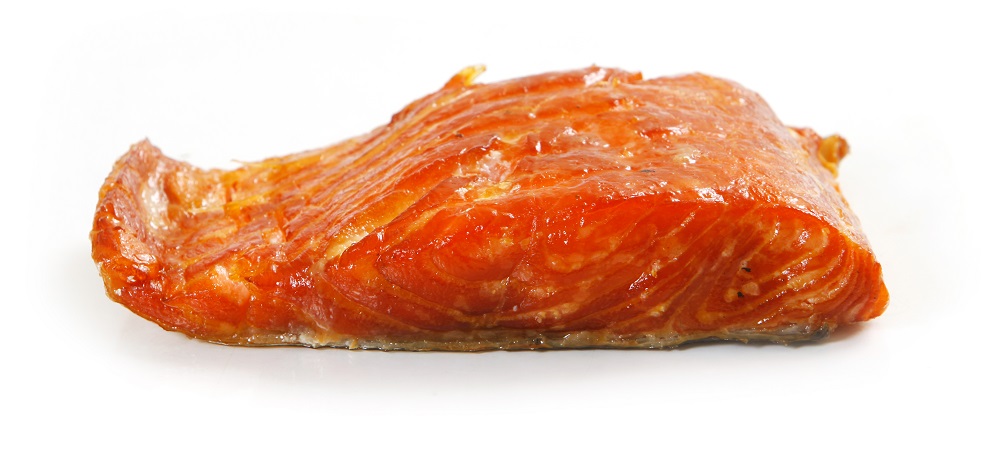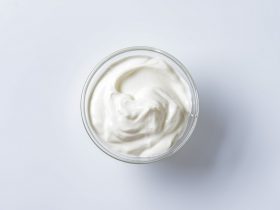Fish is a good source of healthy nutrients during pregnancy, including protein, fats, vitamins, minerals, and omega-3 fatty acids. But fish can also be a source of mercury and other contaminants, as well as food borne pathogens.
Salmon is considered a low-mercury type of fish. It can be safely eaten during pregnancy, as long as it has been properly cooked. Smoked varieties can be uncooked and pose serious health threats to the mother and her baby.
This article highlights the benefits of eating fish, followed by the risk of mercury exposure from fish consumption. It also outlines what smoked salmon is and how it is prepared. Then, the potential food borne pathogens from salmon will be discussed. Lastly, the recommendations on how to safely eat salmon during pregnancy will be explained.
Benefits of Fish Consumption
Fish is a superior source of high-quality protein, amino acids, minerals, vitamins, and fiber that are important for overall health. In addition, it is an important source of the omega-3 fatty acids eicosapentaenoic acid (EPA) and docosahexaenoic acid (DHA) (Hosomi et al., 2012).
There are different types of omega-3 fatty acids in the human diet. One of these is alpha-linolenic acid (ALA), which is found in some vegetable oils, nuts, and seeds, including canola oil, flax oil, walnut oil, walnuts and flax seeds. The human body can convert ALA into other omega-3 fatty acids (Gammone et al., 2019). On the other hand, DHA and EPA are primarily found in products from marine animals. The main food source of omega-3 fatty acids are fish and seafood (Kousoulaki et al., 2015).
The 2007 Canada’s Food Guide recommends consumption of at least two servings (150 grams or 5 ounces) of fish every week for all adults (Hu & Chan, 2021). Meanwhile, the Dietary Guidelines for Americans (DGA) recommends an intake of 8 ounces of seafood per week for all adults (Raatz et al., 2013).
Experts around the world agree with this recommendation, including the WHO/FAO, 2003, the US 2005 Dietary Advisory Committee, the UK Scientific Advisory Committee on Nutrition, 2005, and the European Food Safety Authority (EFSA), 2005.
Cardiovascular Protection in Adults
Studies have shown the association between consumption of omega-3 fatty acids, in particular EPA and DHA, and multiple benefits in relation to reduction of coronary heart disease (CHD), ischemic heart disease (IHD), and stroke. The suggested mechanisms responsible for these effects include the hypotensive, hypotriglyceridemic, anti-arrhythmic, anti-thrombotic, anti-atherogenic and anti-inflammatory properties of omega-3 fatty acids (Kousoulaki et al., 2015).
The World Health Organization (WHO) recommends fish consumption to provide an average daily intake of 200 to 500 milligrams of EPA and DHA (Jensen et al., 2020). Likewise, the International Life Sciences Institute (ILSI) set the recommended dietary intake of combined EPA and DHA to 250 to 500 milligrams per day for CVD risk reduction (Harris et al., 2009). But Makhoul et al. in 2010 went on to suggest that an even higher amount of intake may provide additional protective benefits on chronic disease risk.
The American Heart Association recommends an intake of two servings per week of oily fish, to achieve 400 to 500 milligrams per day of EPA plus DHA. This amount can only be achieved through the diet and would significantly decrease the risk of death from CHD in adults (Harris et al., 2008).
Fish consumption may also prevent against other diseases, such as rheumatoid arthritis, depression, decline in cognitive function, neurological disorders like Alzheimer’s disease, and psoriasis (Kousoulaki et al., 2015).
Benefits for Fetal Development
Fish in the diet of pregnant women provides the following nutrients that are necessary for healthy fetal growth and development (Starling et al., 2015):
- Protein
- Omega-3 fatty acids (EPA and DHA)
- Vitamins B12 and D, which are higher than in any other type of food
- Iron that is important for pregnant women
- Minerals like selenium, zinc and iodine
DHA is a key component of all cell membranes and is particularly abundant in fetal brain and retina (Swanson et al., 2012). Pregnant women with higher intakes of DHA transfer more DHA to their fetus. Hence, guidelines from Australia, Europe, and the USA, all encourage fish consumption during pregnancy (Starling et al., 2015).
The 2010 U.S. Department of Health and Human Services dietary guidelines recommend that pregnant women “consume 8 to 12 ounces of seafood per week from a variety of seafood types”. An intake of this amount is equivalent to approximately 300 to 900 milligrams of EPA plus DHA per day (Swanson et al., 2012).
The U.S. Food and Drug Administration (FDA) and the 2015-2020 DGA, likewise, recommend seafood consumption between 8 and 12 ounces per week from a variety of choices that are lower in mercury for all pregnant women. Starling et al. in 2015 concluded that the benefits of pregnancy diets consisting of moderate amounts of fish outweigh the potential harmful effects with regards to mercury exposure and infant neurodevelopment. However, it is important to consume the type of fish that is low in mercury.
Higher consumption of foods containing omega-3 fatty acids, such as fish, during pregnancy have been associated with increased gestational period and improved fetal outcomes. Preterm birth less than 37 weeks, as well as early preterm birth less than 34 weeks, were both lower in women who received omega-3 fatty acid supplementation, compared to those who did not. Their findings also suggested a possible reduction in the risk of perinatal death and neonatal care admissions (Middleton et al., 2018).
Mercury Exposure from Fish Consumption
Some types of fish contain environmental contaminants like mercury (Forsyth et al., 2004). Mercury is biomagnified along the food chain. Therefore, there is a concern with seafood consumption and mercury contamination causing long-lasting neurobehavioral deficits in exposed infants (Nogara et al., 2019).
In the analysis done by Forsyth et al. in 2004, mercury was detected in all samples of swordfish, marlin, shark and tuna purchased from major supermarkets and fish retailers across Canada. In addition, Dabeka et al. in 2004 found that the mean concentrations of mercury found in swordfish and fresh and frozen tuna were up to three times higher in Canada than reported for the USA.
However, the levels of mercury found in the majority of fish sold in Canada are far below the maximum limit set by Health Canada (Dabeka et al., 2004). Moreover, studies have shown that the benefits of fish consumption outweigh the risks of fetal exposure to mercury.
Hence, pregnant women should choose fish products that are lower in mercury. Some fish that are caught by family or friends, including carp, catfish, trout and perch, are more likely to have higher mercury contents. State advisories should be checked to find out how often these fish can be eaten safely.
Salmon is categorized under the “Best Choices” list under the US FDA recommendation for seafood consumption because of its low mercury content.
What is Smoked Salmon?

Ready to eat (RTE) seafood products have gained popularity because they are relatively easier to prepare. To extend their shelf lives, refrigeration is often combined with mild preservation methods, including salt, smoke, fermentation, vacuum packaging, or modified atmosphere packaging (Hoel et al., 2019).
Mild processing does not completely prevent the growth of microorganisms. This applies to seafood products, including smoked fish (Hoel et al., 2019). Some varieties are undercooked, and are not safe to eat during pregnancy. Smoked salmon can be categorized as either cold or hot smoked, depending on the curing method used.
Cold Smoked Salmon
This type of salmon is dry-cured and smoked at 70 to 90 degrees Fahrenheit (21 to 32 degrees Celsius). It is not fully cooked, which is why it has a brighter color, softer texture, and stronger, fishy flavor. It is often served with spreads, in salads, or atop a toast.
Cold smoked salmon is a leading fish product in the European Union (EU) with 175 thousand tons produced in 2019. It is a lightly preserved fish product with no heat treatment and is generally consumed as an RTE food (Maillet et al., 2021).
The purpose of salting and smoking is to reduce the water activity through dehydration (Leroi et al., 2000). Aside from bringing out certain tastes and aromas, smoking also has a bacteriostatic effect. The chloride ions from salting are also toxic for some organisms (Maillet et al., 2021).
As an RTE product, cold smoked salmon is often contaminated with Listeria monocytogenes. Contamination can happen during the manufacturing process through contact with contaminated surfaces, such as slicers, conveyors, and others (Maillet et al., 2021).
Due to health risks associated with eating undercooked seafood, pregnant women should not consume cold smoked salmon. Other names for cold smoked salmon are the following:
- Pâté
- Nova style
- Fish jerky
- Kippered
Hot Smoked Salmon
This type of salmon is brine-cured and smoked at 120 degrees Fahrenheit (49 degrees Celsius) until the internal temperature reaches 135 degrees Fahrenheit (57 degrees Celsius) or higher. It is fully cooked, and has firm, flaky flesh, and a strong, smoky flavor. It is commonly served in creamy dips, as an entrée, or atop salads and rice bowls.
Potential Food Borne Pathogens in Salmon
A high water content, in addition to its excellent protein, makes fish a good substrate for microbial development (Nespolo et al., 2012). Seafood is an important global source of food borne outbreaks. In the EU, seafood accounted for more than 10 percent of outbreaks in 2015 (Hoel et al., 2019).
The most susceptible groups for food borne infections are children, pregnant women, older adults, and people with weakened immune systems (Lund & O’Brien, 2011).
Listeria Monocytogenes
L. monocytogenes has the ability to grow in high salt concentrations (7-9% weight per volume) and at cold storage temperatures (4 degrees Celsius) (Eicher et al., 2020), and to survive commonly used disinfectants like benzalkonium chloride and peracetic acid (Stoller et al., 2019). It causes the infection listeriosis, which has mortality rates that are high and can range from 15 to 30 percent (Vázquez-Boland et al., 2001).
The elderly, pregnant women, and immunosuppressed individuals are particularly at increased risk for listeriosis. Moreover, specific subpopulations may exist. Pregnant Latina women seem to have a higher risk of listeriosis than pregnant women coming from other ethnic groups, which is most likely due to consumption of contaminated soft cheeses (ILSI Research Foundation; Risk Science Institute, 2005).
The EFSA reported that cases of listeriosis among women aged 25 to 44, which are believed to be related to pregnancy, increased from 2008 to 2015 (Hoel et al., 2019). Pregnant women are up to 18 times more likely to develop listeriosis than the general population. According to the Centers for Disease Control and Prevention (CDC), if the infection occurs during pregnancy, L. monocytogenes can transfer to the baby via the placenta.
Even though the number of listeriosis cases is low (EFSA and ECDC, 2018), the complications can be severe and lead to septicemia and infections of the central nervous system (CNS) (Allerberger & Wagner, 2010). For people in at-risk groups, the mortality rate from listeriosis is as high as 20 to 30 percent (Vogel et al., 2001).
According to the CDC, symptoms of listeriosis during pregnancy can be very mild and include flu-like symptoms, fever, fatigue, and muscle aches. But for unborn babies, the same disease can cause severe and fatal side effects, as infection in pregnant women may lead to abortion, stillbirth, or delivery of an acutely ill infant (Vogel et al., 2001).
The following complications can result from Listeriosis infection during pregnancy:
- Premature delivery
- Low birth weight
- Meningitis – inflammation around brain and spinal cord
- Miscarriage
Still according to the CDC, most patients with invasive listeriosis require hospital care, and about 1 in every 5 people with this infection die. During pregnancy, listeriosis results in fetal loss in around 20 percent of cases and newborn death in around 3 percent of cases.
L. monocytogenes occurs naturally in raw foods. It can grow in many lightly salted and chilled products, which often have extended shelf lives. Typically, L. monocytogenes can be detected in 10 to 40 percent of freshly produced samples of cold smoked fish (Vogel et al., 2001).
According to the EU baseline survey conducted from 2010 to 2011, 17.4 percent of cold smoked fish samples were positive for L. monocytogenes (Eicher et al., 2020). Some production plants can have a prevalence close to 100 percent (Vogel et al., 2001).
The ILSI Risk Science Institute Expert Panel (2005) concluded that foods that are high risk for causing listeriosis have all the following properties:
- Potential for contamination with L. monocytogenes
- Support the growth of L. monocytogenes to high numbers
- Are ready to eat
- Require refrigeration
- Are stored for an extended period of time
L. monocytogenes has been reported in salmon from the United States, Chile, Norway, and Canada. RTE fish products, including cold smoked salmon, have been linked to sporadic cases (Vogel et al., 2001) and outbreaks of listeriosis. In addition, a significant growth potential of L. monocytogenes has been found on tested cold smoked salmon (Eicher et al., 2020).
In 2001, Vogel et al. elucidated the contamination routes for L. monocytogenes in cold smoked salmon processing plants. They found that contamination happened in the brining and slicing areas. However, it cannot be excluded that the source of the contamination of the processing equipment and environment are the raw fish themselves.
Diphyllobothrium Latum
Parasitic infections from fish consumption have become more common with the increasing demand for sushi, sashimi, Carpaccio, tartare, gefilte, and ceviche (Villazanakretzer et al., 2016). Consuming raw or undercooked salmon can lead to parasitic infections (Butt et al., 2004). One of the most common parasites in raw salmon are tapeworms.
According to the CDC, tapeworms can cause stomach aches, nausea, diarrhea, and sudden or extreme weight loss. They may also lead to nutrient deficiencies and intestinal blockages. Diphyllobothrium latum is the largest tapeworm that can infect people. It can grow up to 30 feet long.
Most infections are asymptomatic, but symptoms can include abdominal discomfort, diarrhea, vomiting, and weight loss. Vitamin B12 deficiency can occur and lead to pernicious anemia (decreased number of red blood cells because of lack of vitamin B12).
In the setting of prolonged or severe vitamin B12 deficiency, CNS manifestations like paresthesia and demyelinating symptoms, as well as respiratory manifestations like dyspnea, may be seen (Scholz et al., 2009). Complications, such as intestinal obstruction and gall bladder disease from migration of proglottids (one of the segments of a tapeworm), may ensue.
Humans get infected by eating raw or undercooked fish, including salmon, trout, perch, and walleyed pike. Diphyllobothrium infection generally occurs in the Northern Hemisphere, including Europe, newly independent states of the Former Soviet Union, North America, and Asia. However, fish infected with Diphyllobothrium larvae may be transported to any area of the world.
Salmon can live in both fresh and salt water, and can harbor D. latum larvae. Lightly salted, smoked, or pickled fish can contain this infectious organism.
The primary impact of a parasitic infection on pregnant women is anemia and altered immunity, which in turn, may increase the risk of a maternal infection. The main fetal effects include intrauterine growth restriction and preterm delivery (Villazanakretzer et al., 2016).
Eating Smoked Salmon Safely During Pregnancy
Salmon is a good source of EPA and DHA. A portion of 200 grams per week of both farmed and wild Atlantic salmon can contribute 3.2 grams and 2.8 grams, respectively, of EPA and DHA, which is almost twice the recommendation for adults (250 mg/day or 1.75 grams/week) by the EFSA (Lundebye et al., 2017).
According to Environment Canada, the nutritional content found in every 75 grams of cooked salmon are the following:
| Atlantic salmon, farmed | Sockeye salmon, canned | Coho salmon, wild | |
| Total fat in (g) | 9.26 | 7.58 | 3.22 |
| ALA (mg) | 85 | 65 | 41 |
| DHA (mg) | 1093 | 835 | 494 |
| EPA (mg) | 518 | 554 | 301 |
| Saturated fat (g) | 1.88 | 1.75 | 0.79 |
| Iron (mg) | 0.26 | 0.67 | 0.28 |
| Magnesium (mg) | 22 | 21 | 23 |
| Potassium (mg) | 288 | 262 | 326 |
| Zinc (mg) | 0.32 | 0.58 | 0.42 |
| Selenium (mcg) | 31 | 26.6 | 28.5 |
| Vitamin D (mcg) | 5.10 | 14.62 | 12.67 |
All essential amino acids were found to be present in high amounts in Atlantic salmon, hence, its protein is of high quality. The protein content in wild Atlantic salmon was found to be slightly higher compared to farmed ones, but the amount of essential amino acids was similar. The fat content of farmed salmon was three times that of wild ones (Jensen et al., 2020).
Both farmed and wild Atlantic salmon are excellent sources of EPA and DHA. A serving of 150 grams per week will contribute to 2.1 grams and 1.8 grams, respectively, which are more than the recommended weekly intake for adults (Jensen et al., 2020).
Mercury levels are lower in farmed than in wild salmon (Lundebye et al., 2017). The concentration of mercury was three times higher in wild (56.6 mcg/kg) compared to farmed Atlantic salmon (18.1 mcg/kg). However, these are well below the EU maximum level of 0.5 mg/kg mercury limit (Jensen et al., 2020).
Adequate cooking is the safest way of preventing food borne infections associated with seafood consumption (Butt et al., 2004). Pregnant women should never eat raw or undercooked fish, and should avoid sushi, sashimi, raw oysters, raw clams, raw scallops, and ceviche.
The US FDA recommends the following for preparation or storage of fish to kill parasites:
- Cooking: Cook fish adequately to an internal temperature of at least 145 degrees Fahrenheit (63 degrees Celsius)
- Freezing:
- At -4 degrees Fahrenheit (-20 degrees Celsius) or below for 7 days
- At -31 degrees Fahrenheit (-35 degrees Celsius) or below for 15 hours
- At -4 degrees Fahrenheit (-20 degrees Celsius) or below for 24 hours
When heating is not performed, an important blockade against transfer of pathogenic organisms is lost. Therefore, consumption of raw or undercooked seafood can lead to various diseases (Hoel et al., 2019). Eating fresh raw salmon, as sushi and sashimi, can expose consumers to different pathogens and may lead to a simple gastroenteritis or death (Nespolo et al., 2012).
Therefore, all seafood dishes should be cooked to achieve an internal temperature of 145 degrees Fahrenheit. Pregnant women should reheat even hot smoked salmon before consumption. Refrigerated smoked salmon should not be eaten during pregnancy, unless it is an ingredient in a cooked dish, such as a casserole, that reaches a safe internal temperature.
According to the NHS, pregnant women should not eat more than two servings of oily fish per week, including salmon, because of the risk of pollutants such as dioxins and polychlorinated biphenyls (PCBs) in oily fish.
Final Thoughts
Pregnant women should be able to make informed choices regarding their seafood intake. Eating fish during pregnancy offers a lot of benefits for the mother and her infant. However, it is important to eat only the cooked varieties.
Eating cold smoked salmon puts pregnant women at risk for tapeworm and listeriosis infections. Therefore, pregnant women should not eat raw or undercooked smoked salmon. Smoked salmon can be safely consumed during pregnancy, only when heated to at least 145 degrees Fahrenheit.
Talk to a doctor for further dietary advice regarding fish consumption during pregnancy.
References
- https://www.healthline.com/nutrition/smoked-salmon-pregnancy
- https://www.fda.gov/food/consumers/advice-about-eating-fish
- https://www.foodsafety.gov/people-at-risk/pregnant-women
- https://www.canada.ca/en/health-canada/services/publications/food-nutrition/prenatal-nutrition-guidelines-health-professionals-fish-omega-3-fatty-acids-2009.html
- https://www.cdc.gov/listeria/faq.html
- https://www.cdc.gov/parasites/diphyllobothrium/faqs.html
- https://www.nhs.uk/pregnancy/keeping-well/foods-to-avoid/
- Allerberger, F., & Wagner, M. (2010). Listeriosis: A resurgent foodborne infection. Clinical Microbiology and Infection 16(1), 16-23. doi: 10.1111/j.1469-0691.2009.03109.x
- Butt, A., Aldridge, K., & Sanders, C. (2004). Infections related to the ingestion of seafood. Part II: Parasitic infections and food safety. The Lancet: Infectious Diseases 4(5), 294-300. doi: 10.1016/S1473-3099(04)01005-9
- Dabeka, R., McKenzie, A. D., Forsyth, D. S., & Conacher, H. B. (2004). Survey of total mercury in some edible fish and shellfish species collected in Canada in 2002. Food Additives and Contaminants 21(5), 434-440. doi: 10.1080/02652030410001670184
- Eicher, C., Subira, A. R., Corti, S., Meusburger, A., Stephan, R., & Guldimann, C. (2020). Growth potential of Listeria monocytogenes in three different salmon products. Foods 9(8), 1048. doi: 10.3390/foods9081048
- European Food Safety Authority and European Centre for Disease Prevention and Control (EFSA and ECDC). (2018). The European Union summary report on trends and sources of zoonoses, zoonotic agents and food-borne outbreaks in 2017. EFSA Journal 16(12), e05500. doi: 10.2903/j.efsa.2018.5500
- Forsyth, D., Casey, V., Dabeka, R. W., & McKenzie, A. (2004). Methylmercury levels in predatory fish species marketed in Canada. Food Additives and Contaminants 21(9), 849-856. doi: 10.1080/02652030400004259
- Gammone, M. A., Riccioni, G., Parrinello, G., & D’Orazio, N. (2019). Omega-3 polyunsaturated fatty acids: Benefits and endpoints in sport. Nutrients 11(1), 46. doi: 10.3390/nu11010046
- Harris, W., Kris-Etherton, P., & Harris, K. (2008). Intakes of long-chain omega-3 fatty acid associated with reduced risk for death from coronary heart disease in healthy adults. Current Atherosclerosis Reports 10(6), 503-509. doi: 10.1007/s11883-008-0078-z
- Harris, W., Mozaffarian, D., Lefevre, M., Toner, C., Colombo, J., Cunnane, S., …, & Whelan, J. (2009). Towards establishing dietary reference intakes for eicosapentaenoic and docosahexaenoic acids. The Journal of Nutrition 139(4), 804S-819S. doi: 10.3945/jn.108.101329
- Hoel, S., Vadstein, O., & Jakobsen, A. (2019). The significance of mesophilic Aeromonas spp. In minimally processed ready-to-eat seafood. Microorganisms 7(3), 91. doi: 10.3390/microorganisms7030091
- Hosomi, R., Yoshida, M., & Fukunaga, K. (2012). Seafood consumption and components for health. Global Journal of Health Science 4(3), 72-86. doi: 10.5539/gjhs.v4n3p72
- Hu, X. F., & Chan, H. M. (2021). Seafood consumption and its contribution to nutrients intake among Canadians in 2004 and 2015. Nutrients 13(1), 77. doi: 10.3390/nu13010077
- ILSI Research Foundation; Risk Science Institute. (2005). Achieving continuous improvement in reductions in foodborne listeriosis: A risk-based approach. Journal of Food Protection 68(9), 1932-1994. doi: 10.4315/0362-028x-68.9.1932
- Jensen, I., Eilertsen, K., Otnaæs, C. H., Mæhre, H., & Elvevoll, E. O. (2020). An update on the content of fatty acids, dioxins, PCBs and heavy metals in farmed, escaped and wild Atlantic salmon (Salmo salar L.) in Norway. Foods 9(12), 1901. doi: 10.3390/foods9121901
- Kousoulaki, K., Østbye, T. K., Krasnov, A., Torgersen, J. S., Mørkøre, T., & Sweetman, J. (2015). Metabolism, health and fillet nutritional quality in Atlantic salmon (Salmo salar) fed diets containing n-3-rich microalgae. Journal of Nutritional Science 4, e24. doi: 10.1017/jns.2015.14
- Leroi, F., Joffraud, J. J., & Chevalier, F. (2000). Effect of salt and smoke on the microbiological quality of cold-smoked salmon during storage at 5 degrees C as estimated by the factorial design method. Journal of Food Protection 63(4), 502-508. doi: 10.4315/0362-028x-63.4.502
- Lund, B., & O’Brien, S. (2011). The occurrence and prevention of foodborne disease in vulnerable people. Foodborne Pathogens and Disease 8(9), 961-973. doi: 10.1089/fpd.2011.0860
- Lundebye, A., Lock, E., Rasinger, J., Nøstbakken, O. J., Hannisdal, R., Karlsbakk, E., …, & Ørnsrud, R. (2017). Lower levels of persistent organic pollutants, metals and the marine omega 3-fatty acid DHA in farmed compared to wild Atlantic salmon (Salmo salar). Environmental Research 155, 49-59. doi: 10.1016/j.envres.2017.01.026
- Maillet, A., Denojean, P., Bouju-Albert, A., Scaon, E., Leuillet, S., Dousset, X., …, & Prévost, H. (2021). Characterization of bacterial communities of cold-smoked salmon during storage. Foods 10(2), 362. doi: 10.3390/foods10020362
- Makhoul, Z., Kristal, A., Gulati, R., Luick, B., Bersamin, A., Boyer, B., & Mohatt, G. (2010). Associations of very high intakes of eicosapentaenoic and docosahexaenoic acids with biomarkers of chronic disease risk among Yup’ik eskimos. The American Journal of Clinical Nutrition 91(3), 777-785. doi: 10.3945/ajcn.2009.28820
- Middleton, P., Gomersall, J., Gould, J., Shepherd, E., Olsen, S., & Makrides, M. (2018). Omega-3 fatty acid addition during pregnancy. The Cochrane Database of Systematic Reviews 2018(11), CD003402. https://doi.org/10.1002/14651858.CD003402.pub3
- Nespolo, N. M., Martinelli, T. M., & Rossi, O. D., Jr. (2012). Microbiological quality of salmon (Salmo salar) sold in cities of the state of SãO Paulo, Brazil. Brazilian Journal of Microbiology 43(4), 1393-1400. doi: 10.1590/S1517-838220120004000021
- Nogara, P., Farina, M., Aschner, M., & Rocha, J. (2019). Mercury in our food. Chemical Research in Toxicology 32(8), 1459-1461. doi: 10.1021/acs.chemrestox.9b00126
- Raatz, S. K., Rosenberger, T. A., Johnson, L. K., Wolters, W. W., Burr, G. S., & Picklo, M. J., Sr. (2013). Dose-dependent consumption of farmed Atlantic salmon (Salmo salar) increases plasma phospholipid n-3 fatty acids differentially. Journal of the Academy of Nutrition and Dietetics, 113(2), 282–287. https://doi.org/10.1016/j.jand.2012.09.022
- Scholz, T., Garcia, H., Kuchta, R., & Wicht, B. (2009). Update on the human broad tapeworm (genus Diphyllobothrium), including clinical relevance. Clinical Microbiology Reviews 22(1), 146-160. doi: 10.1128/CMR.00033-08
- Starling, P., Charlton, K., McMahon, A., & Lucas, C. (2015). Fish intake during pregnancy and foetal neurodevelopment: A systematic review of the evidence. Nutrients 7(3), 2001-2014. doi: 10.3390/nu7032001
- Stoller, A., Stevens, M. J., Stephan, R., & Guldimann, C. (2019). Characteristics of Listeria monocytogenes strains persisting in a meat processing facility over a 4-year period. Pathogens 8(1), 32. doi: 10.3390/pathogens8010032
- Swanson, D., Block, R., & Mousa, S. Omega-3 fatty acids EPA and DHA: Health benefits throughout life. Advances in Nutrition 3(1), 1-7. doi: 10.3945/an.111.000893
- Vázquez-Boland, J. A., Kuhn, M., Berche, P., Chakraborty, T., Domínguez-Bernal, G., Goebel, W., …, & Kreft, J. (2001). Listeria pathogenesis and molecular virulence determinants. Clinical Microbiology Reviews 14(3), 584-640. doi: 10.1128/CMR.14.3.584-640.2001
- Villazanakretzer, D., Napolitano, P., Cummings, K., & Magann, E. (2016). Fish parasites: A growing concern during pregnancy. Obstetrical & Gynecological Survey 71(4), 253-259. doi: 10.1097/OGX.0000000000000303
- Vogel, B. F., Huss, H. H., Ojeniyi, B., Ahrens, P., & Gram, L. (2001). Elucidation of Listeria monocytogenes contamination routes in cold-smoked salmon processing plants detected by DNA-based typing methods. Applied and Environmental Microbiology 67(6), 2586-2595. doi: 10.1128/AEM.67.6.2586-2595.2001




